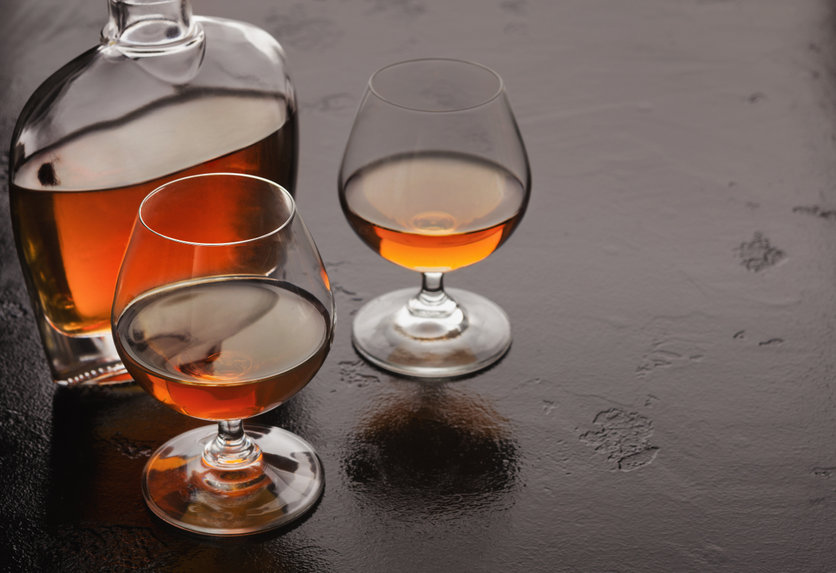
Brandy is a spirit made from distilled wine that is barrel-aged. Traditional brandy is made from grapes, but there are various recipes that make use of flavorful fruits like peaches, apples, blackberries, and pears. Brandy is an aromatic and rich liquor that is the staple of many west and central European countries. The drink can be bottled right after the distillation process, or aged in wooden barrels to give it a complex flavor profile. There was a time when brandy was only a connoisseur’s drink, but its popularity has surged in American markets due to the rise in consumer awareness. It is not difficult to find top-shelf brandy adjacent to the finest scotch and bourbons in supermarkets and liquor stores today.
How to Drink Brandy
Brandy can be enjoyed in many ways, with the primary three serving methods being:
- Neat: Neat means that the liquor is poured straight into the serving glass from the bottle or decanter and served directly without any additions. This is the most common way of serving good brandy.
- On the Rocks: Brandy served this way is poured on ice to cool it down. This is one of the more popular ways of enjoying the drink in warm weather. Make sure that your bar is stocked with plenty of ice to serve brandy when it’s hot outside.
- In Cocktails: There are several versions of brandy-based cocktails that make use of the liquor’s rich and aromatic flavors to create alcoholic beverages that envelop the senses and offer a refreshing experience.
Every brandy drinker has their own opinion on the best way to serve brandy, so it’s a good idea to make sure that your bar is well-equipped to serve all styles of the grape-based spirit.
How to Serve Brandy
Brandy is a complex spirit with subtle notes to its flavor and calls for a degree of bartending flair while pouring it into a glass. Being served brandy is as much of an experience to the customer as it is a ritual drinking it. A bartender who is well acquainted with the spirit should know the following:
- Although wine and brandy are closely related, brandy does not need to “breathe” before it is poured into a glass. The drink is ready for the patron as soon as the bottle or decanter is opened.
- Choosing the right type of glass for serving brandy is crucial. The drink is typically presented in snifter glasses when served neat. The wide, bowl-shaped glass allows the patron to hold the bottom of the snifter in the palm of their hand to warm up the drink. It can be swirled to release the fragrant and aromatic notes of the liquor. The narrow top of the glass directs these aromas to the nose of the drinker and enhances every sip they take.
- Brandy is typically poured at an angle to get an even portion without the need to measure it. It is good practice to hold the glass horizontally and pour the drink into the bowl of the glass until the beverage reaches the rim. This ensures an even and smooth pour every time.
- Once the brandy has been poured into the glass, hand it directly to the customer so that they can warm up their drink in their hands and enjoy its complex aroma.
How to Drink Brandy Straight
The best way to drink brandy during cool weather is to have it neat. High-quality brandies are typically served this way so that the flavors and aromas are not diluted. To get the most out of the experience, brandy connoisseurs have made a ritual that allows them to imbibe all that the drink has to offer.
Starting off with a dry glass, the brandy is poured and held in the palm of the hand to warm it up. This allows the molecules of the alcohol to open up and release their aromas. It is an uncommon, but still, prevalent practice to warm up the snifter before serving. This is usually accomplished by using hot water to rinse the glass. The glass is then cleaned and dried to get rid of any residual water that may affect the flavor profile of the brandy. Swirling the drink also helps release the aromas and warms up the drink evenly. The brandy is then held at chest height to get a better look at its color and imbibe the fragrance. Darker and barrel-aged brandies have a more defined and robust aroma. As the glass is moved closer to the chin, it gets easier to smell the undertones and complexities of the spirit. The fruit used to make the brandy makes an appearance here and it gets easier to identify the complex notes given off by the alcohol. Starting off with a small sip, you can taste the drink on your lips so that your taste buds are not suddenly overwhelmed by the alcohol. Once your palate is acclimated to the drink, you can take larger sips to truly appreciate the intricate flavors and aromas. Some brandy drinkers also like to add a few drops of water to the drink to further release flavors and enhance their drinking experience.
How to Drink Brandy with Ice
Serving brandy with ice is somewhat uncommon, but your bar should still be prepared for it. The first step to serving the drink is presenting the customer with a small sample to appreciate the spirit in its natural state. Once they have warmed up the drink, swirled it, and smelled the spirit, the patron should be ready to compare the differences between chilled and straight brandy. When serving brandy on the rocks, it is a good idea to serve it with large ice cubes that don’t melt quickly and dilute the flavor. After the ice is added to the drink, let it sit and cool down to tone down the alcoholic flavors of the brandy. The drink should soon cool down to an optimal temperature for drinking and is then ready for tasting.
Types of Brandy
- Cognac: One of the most sought-after brandies, Cognac is known for being distilled twice, as well as its fruity and oaky flavors. It takes its name from the Cognac region of France, where only three types of grapes are used to produce this brandy.
- Armagnac: This kind of brandy is produced in the Armagnac region of France and has fruity and toffee-like notes to the flavor. Armagnacs also have a higher alcohol content than Cognacs.
- Brandy de Jerez: Brandy de Jerez is a specialty from the Jerez region of Spain. This blended brandy mixes various aged brandies to give it a complex profile. Because it is aged in sherry casks, it is dark in color and has a rich flavor.
- Fruit Brandies: Fruit brandies can be made using a variety of fruits, including apples, peaches, pears, and cherries. These brandies are often fruity in flavor and can be served relatively young in the aging process.
Whether you are serving top-shelf Cognacs to the connoisseur or introducing a new patron to fruit brandies, having a good selection of the fruit-based spirit will certainly elevate the reputation of your bar. Brandy is an excellent choice to spruce up your drinks menu and stocking up on various kinds of liquor will provide your patrons with many quality options to choose from. Straight, on the rocks, or in a cocktail - how do you drink your brandy?












